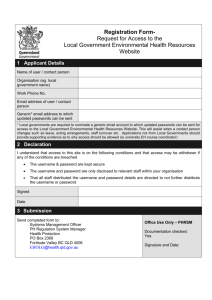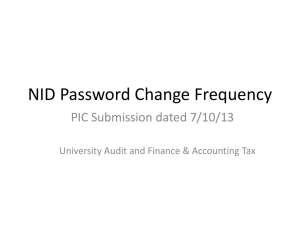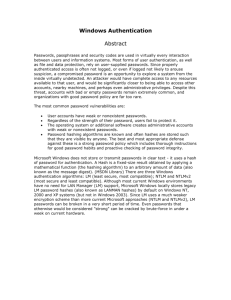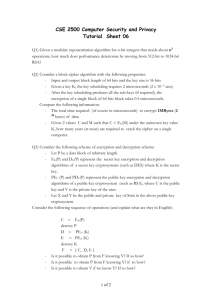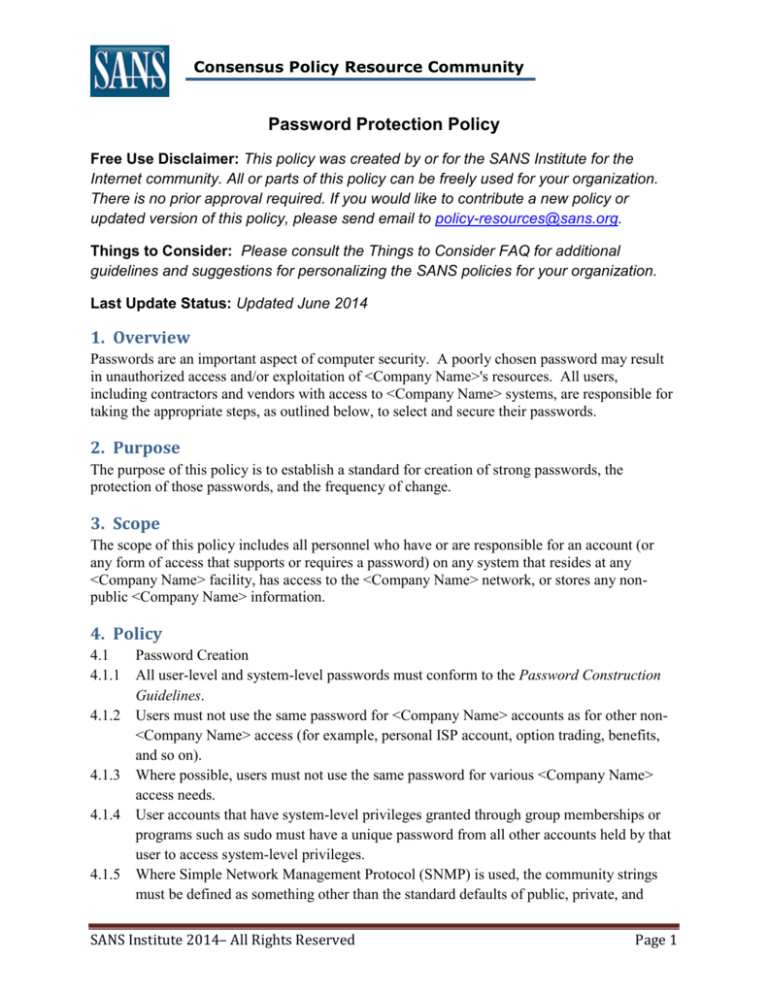
Consensus Policy Resource Community
Password Protection Policy
Free Use Disclaimer: This policy was created by or for the SANS Institute for the
Internet community. All or parts of this policy can be freely used for your organization.
There is no prior approval required. If you would like to contribute a new policy or
updated version of this policy, please send email to policy-resources@sans.org.
Things to Consider: Please consult the Things to Consider FAQ for additional
guidelines and suggestions for personalizing the SANS policies for your organization.
Last Update Status: Updated June 2014
1. Overview
Passwords are an important aspect of computer security. A poorly chosen password may result
in unauthorized access and/or exploitation of <Company Name>'s resources. All users,
including contractors and vendors with access to <Company Name> systems, are responsible for
taking the appropriate steps, as outlined below, to select and secure their passwords.
2. Purpose
The purpose of this policy is to establish a standard for creation of strong passwords, the
protection of those passwords, and the frequency of change.
3. Scope
The scope of this policy includes all personnel who have or are responsible for an account (or
any form of access that supports or requires a password) on any system that resides at any
<Company Name> facility, has access to the <Company Name> network, or stores any nonpublic <Company Name> information.
4. Policy
4.1
Password Creation
4.1.1 All user-level and system-level passwords must conform to the Password Construction
Guidelines.
4.1.2 Users must not use the same password for <Company Name> accounts as for other non<Company Name> access (for example, personal ISP account, option trading, benefits,
and so on).
4.1.3 Where possible, users must not use the same password for various <Company Name>
access needs.
4.1.4 User accounts that have system-level privileges granted through group memberships or
programs such as sudo must have a unique password from all other accounts held by that
user to access system-level privileges.
4.1.5 Where Simple Network Management Protocol (SNMP) is used, the community strings
must be defined as something other than the standard defaults of public, private, and
SANS Institute 2014– All Rights Reserved
Page 1
Consensus Policy Resource Community
system and must be different from the passwords used to log in interactively. SNMP
community strings must meet password construction guidelines.
4.2
Password Change
4.2.1 All system-level passwords (for example, root, enable, NT admin, application
administration accounts, and so on) must be changed on at least a quarterly basis.
4.2.2 All user-level passwords (for example, email, web, desktop computer, and so on) must be
changed at least every six months. The recommended change interval is every four
months.
4.2.3 Password cracking or guessing may be performed on a periodic or random basis by the
Infosec Team or its delegates. If a password is guessed or cracked during one of these
scans, the user will be required to change it to be in compliance with the Password
Construction Guidelines.
4.3
Password Protection
4.3.1 Passwords must not be shared with anyone. All passwords are to be treated as sensitive,
Confidential <Company Name> information. Corporate Information Security recognizes
that legacy applications do not support proxy systems in place. Please refer to the
technical reference for additional details.
4.3.2 Passwords must not be inserted into email messages, Alliance cases or other forms of
electronic communication.
4.3.3 Passwords must not be revealed over the phone to anyone.
4.3.4 Do not reveal a password on questionnaires or security forms.
4.3.5 Do not hint at the format of a password (for example, "my family name").
4.3.6 Do not share <Company Name> passwords with anyone, including administrative
assistants, secretaries, managers, co-workers while on vacation, and family members.
4.3.7 Do not write passwords down and store them anywhere in your office. Do not store
passwords in a file on a computer system or mobile devices (phone, tablet) without
encryption.
4.3.8 Do not use the "Remember Password" feature of applications (for example, web
browsers).
4.3.9 Any user suspecting that his/her password may have been compromised must report the
incident and change all passwords.
4.4
Application Development
Application developers must ensure that their programs contain the following security
precautions:
4.4.1 Applications must support authentication of individual users, not groups.
SANS Institute 2014– All Rights Reserved
Page 2
Consensus Policy Resource Community
4.4.2 Applications must not store passwords in clear text or in any easily reversible form.
4.4.3 Applications must not transmit passwords in clear text over the network.
4.4.4 Applications must provide for some sort of role management, such that one user can take
over the functions of another without having to know the other's password.
4.5 Use of Passwords and Passphrases
Passphrases are generally used for public/private key authentication. A public/private key system
defines a mathematical relationship between the public key that is known by all, and the private
key, that is known only to the user. Without the passphrase to "unlock" the private key, the user
cannot gain access.
Passphrases are not the same as passwords. A passphrase is a longer version of a password and
is, therefore, more secure. A passphrase is typically composed of multiple words. Because of
this, a passphrase is more secure against "dictionary attacks."
A good passphrase is relatively long and contains a combination of upper and lowercase letters
and numeric and punctuation characters. An example of a good passphrase:
"The*?#>*@TrafficOnThe101Was*&#!#ThisMorning"
All of the rules above that apply to passwords apply to passphrases.
5. Policy Compliance
5.1 Compliance Measurement
The Infosec team will verify compliance to this policy through various methods, including but
not limited to, periodic walk-thrus, video monitoring, business tool reports, internal and external
audits, and feedback to the policy owner.
5.2 Exceptions
Any exception to the policy must be approved by the Infosec Team in advance.
5.3 Non-Compliance
An employee found to have violated this policy may be subject to disciplinary action, up to and
including termination of employment.
6 Related Standards, Policies and Processes
Password Construction Guidelines
7 Definitions and Terms
The following definition and terms can be found in the SANS Glossary located at:
https://www.sans.org/security-resources/glossary-of-terms/
SANS Institute 2014– All Rights Reserved
Page 3
Consensus Policy Resource Community
Simple Network Management Protocol (SNMP)
8 Revision History
Date of Change
Responsible
Summary of Change
June 2014
SANS Policy Team
Updated and converted to new format.
SANS Institute 2014– All Rights Reserved
Page 4




